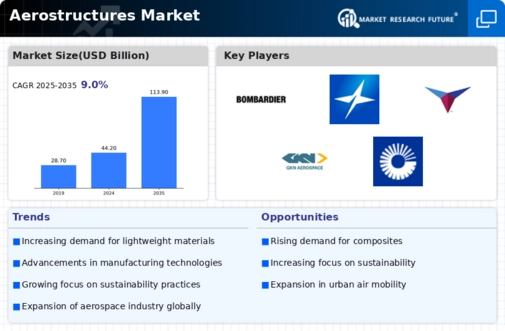Market Share
Aerostructures Market Share Analysis
Aerostructures Market is a witness to transformative trends that reshape aerospace. These trends influence the dynamics of the manufacturing of aerostructures. One of those trends which are leading is the growing acceptance of innovative materials and manufacturing techniques for aerospace products. Aerospace manufacturers now find recourse in new materials, such as composites and advanced alloys, to make stronger aerostructures with minimum weight gain. Concerning industry focus on environmental sustainability, lightweight aerostructures lead to reduced emission levels, fuel efficiency, and better aircraft performance. This trend has led to more efficient production processes like 3D printing and automatic assembly that can lower costs while enabling more customized aerostructure construction.
Digitalization and Industry 4.0 technologies have shaped Aerostructures Market trends greatly; these factors are being used as game-changing elements by companies involved in the market race for dominance. The integration of digital technologies such as AI, ML and digital twins is transforming the design, production and maintenance processes of aerostructures completely. A fleet manager can always monitor his/her airplane’s condition through real-time simulation due to digital twins which also allow them forecast maintenance thus optimizing its overall lifecycle management process among many other capabilities achieved through this technology. Digitalization helps avoid downtimes thus contributes towards smart cooling systems within connected wings that are part of an industry-wide digitization movement.
In Aerostructures Market, customization and modular design are becoming major market drivers. As global demand becomes increasingly diverse while some clients’ requirements become increasingly precise, we see that adaptable solutions are preferred much more than their counterparts where modularity is not possible or feasible at least using conventional methods currently based on current survey among industry experts taking into consideration all types of customers. Modular designs will enable components integration in different aircraft configurations reducing lead time while increasing flexibility in manufacturing operations compared to customizing each component respectively which lengthens time taken before launching new product versions out into market places servicing various categories within both public commercial spaces like airports.
Aerostructures Market is driven by sustainability and environmental consciousness. In order to reduce aviation’s impact on the environment, manufacturers are looking into factors such as ecological materials, recycling processes as well as sustainable ways of production. The use of composites and recyclable materials in aerostructures aligns with the industry’s goals of minimizing waste and enhancing end-of-life recyclability. On top of satisfying global environmental regulations, the practice of better environmental responsibility also gains support from airlines and customers who are becoming more concerned about ecology; this will also cause demand for aerostructures having less negative influence on nature.
The Aerostructures Market is being affected by an increasing trend towards outsourcing and global collaboration. To improve efficiency, lower costs, or gain access to unique skills, aerospace firms now rely more on global chains involving suppliers and partners. By outsourcing some of these manufacturing operations related to aerostructure production companies have been able to focus on their core competencies while at the same time optimizing their resources through taking advantages associated with different regions in term comparative advantages. This trend allows for knowledge sharing among various stakeholders thus promoting innovation which is crucial for the market competitiveness within aerostructures sector at large.
Urban air mobility and the development of electric and hybrid-electric aircraft are affecting market trends in the Aerostructures Market. The rise in urban air mobility concepts including eVTOL (electric vertical take-off landing) has led to the need for new aero-structures that work best within these contexts hence creating demand. At present, there is additional pressure on assessing how eVTOLs will affect fixed wing airframes since this technology requires rethinking traditional designs used up until now due its focus upon electrified propulsion systems instead of burning hydrocarbons like jet fuel which make it environmentally sound option but also rendering it non-viable choice if all becomes become digitalized one day just like most other technologies we use today were originally only digital at the beginning.
This trend supports the industry’s pursuit of cleaner and more sustainable propulsion technologies, which in turn fuels the evolution of aerostructures for next generation aircrafts.
Supply chain resilience and risk management are two trends that are increasingly important in Aerostructures Market. Global events, geopolitical tensions, and unforeseen crises can disrupt the aerospace industry. As a way of dealing with this, manufacturers stress that resilient supply chains should be built. Diversification of suppliers, ensuring there is redundancy as well as establishing robust risk management strategies are some of the ways aimed at making Aerostructures Market more agile which would enable firms to deal with uncertainties effectively and cushion themselves from possible disruptions.








Leave a Comment